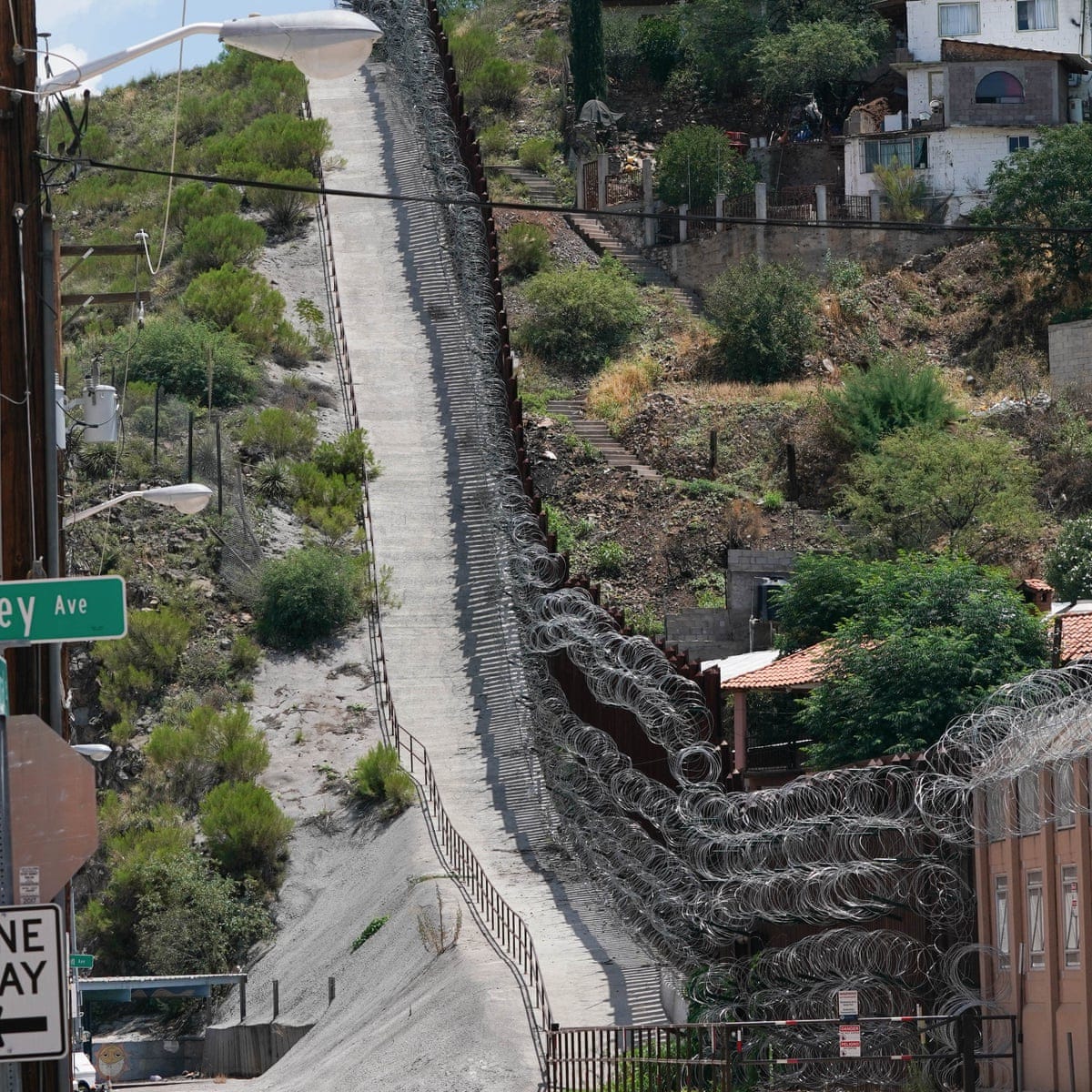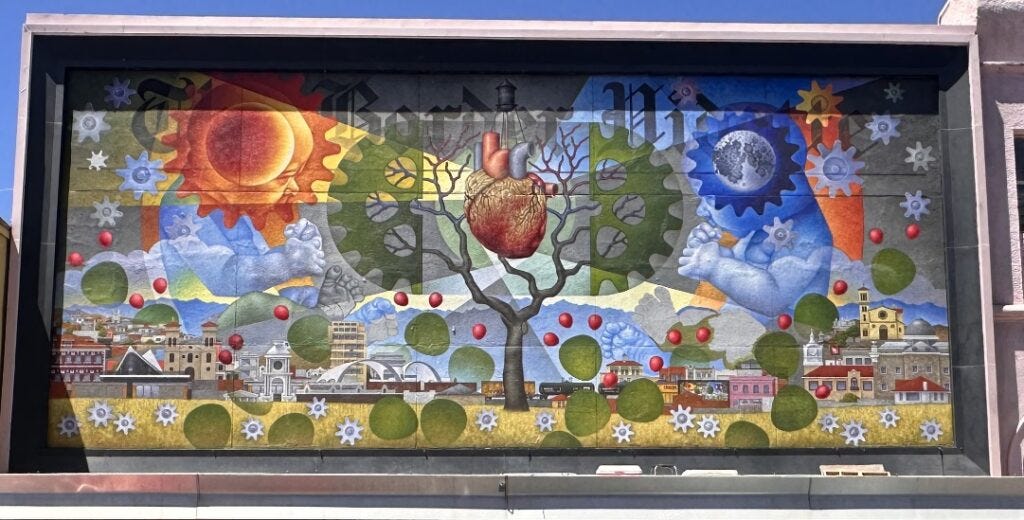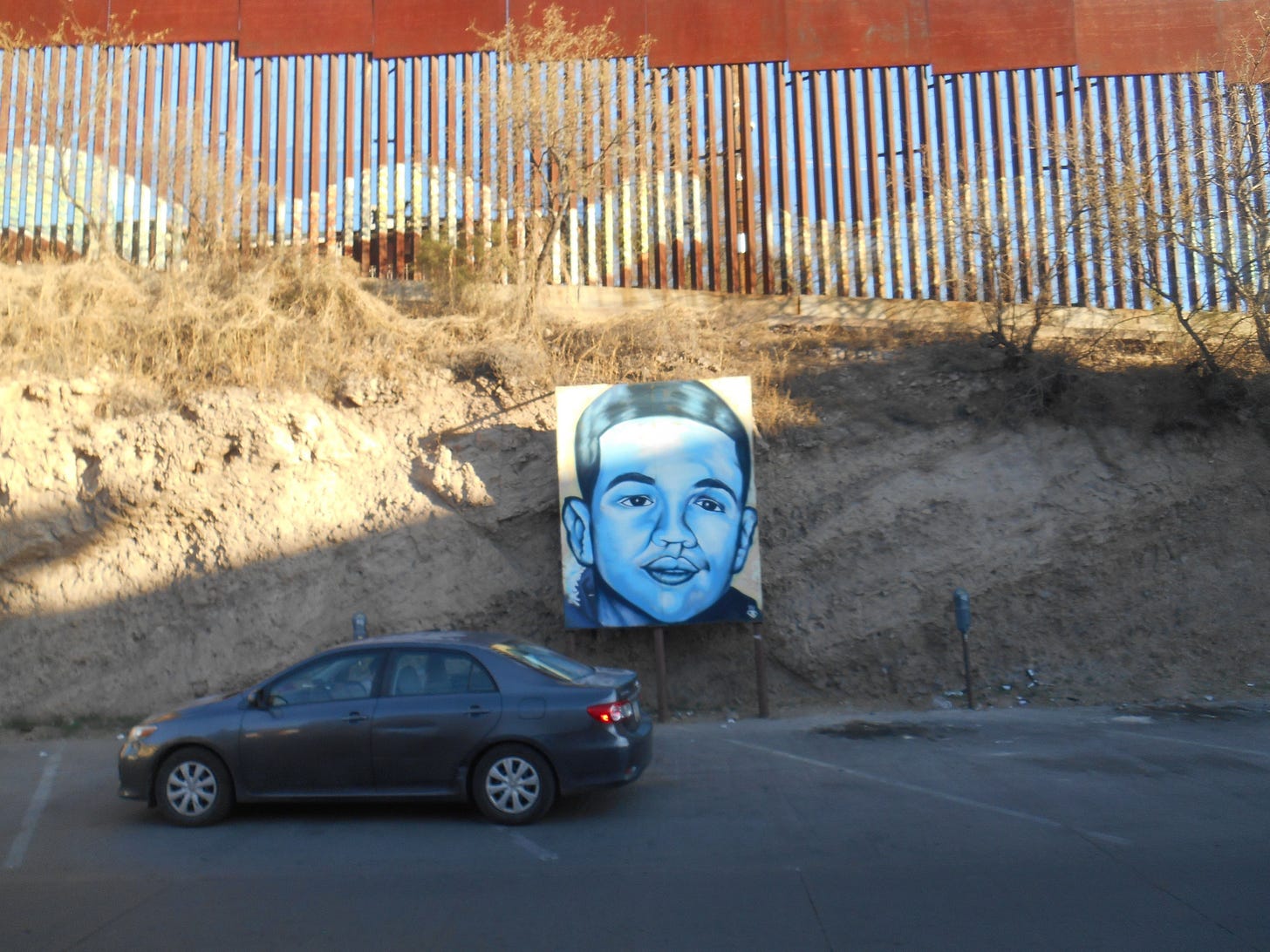Dear people who I adore and miss,
Welcome back to Creed’s Southwest Summer Substack! It has been an eventful week since I wrote my first letter (which you can read below).
Letter #1
Hello friends, family, teachers, and mentors, and welcome to Creed’s Southwest Summer Substack!
In this letter, and all of my letters to come this summer, I will be talking about my experiences working, living, and learning in borderlands, and much of these experiences will deal with immigration. I want to preface my discussion of immigration by explaining some critical history that is terribly absent in the popular understanding of immigration: US interventionism directly caused the contemporary migration crisis.
In high school, I believed care for immigrants to be benevolent; I thought it was moral, though not necessarily “the United States’ problem.” In two college seminars (“Neoliberalism and Sexuality” and “Latin American Immigration to the US”), I’ve since learned about the United States’ historical and ongoing role in producing the political conditions that force hundreds of thousands of Latin Americans to flee their homes: in the last 6 decades, the United States has clandestinely and violently mettled in tens of governments, unseating democratically elected left-wing leaders across tens of countries in Latin America (this happened in the ‘60s in Chile and Argentina and more recently in Honduras and Venezuela). Thus, caring for immigrants is not benevolent, but is “the United States’ problem.” For more information on how US interventionism in Latin America has produced migration, I’m hoping to read Everyone Who is Gone is Here (or at least this book review).
Again, I say this as a preface to my experiences in the borderlands because this history is grossly underrepresented in popular media on immigration. With that preface given, let’s get into what I’ve experienced this last week!
What have I been up to this last week?
On Wednesday this week, we started with an orientation power point, some intention-setting, and a get-to-know-you exercise. Amy Tice, the incredible coordinator for the BCA Internship Program, guided us in this. I really enjoyed starting the program with mindfulness.
That afternoon, we went down to Nogales, Arizona, where I saw the border wall for the first time. In the classroom, I’ve studied how borders are not objective or permanent; even if they do follow a geographic feature or the spread of peoples (which is often not the case), borders are socially constructed. Seeing the border wall in person made it abundantly clear that the Arizona-Sonora border—especially in its present location, where it has been since the Gadsden Purchase went into effect in 1854—is unnatural. In Nogales, it is evident that the border line was chosen abstractly, without any knowledge of the communities or topographical features it would bisect.
(I found this image online, which is the only reason that I was able to successfully embed a photo into this letter.)
After first seeing the border, the rest of the day had a lighter tone. We met up with Nogales native Evan Kory, a Julliard- and Manhattan School of Music-trained pianist and harpsichordist who is involved in developing Nogales’ blossoming art scene. He showed us around downtown Nogales, AZ. We saw: the Wittner Museum, where you’re surrounded by hundreds of Nogales-based painter Paula Wittner’s surrealist paintings; La Linea art studio, a small gallery and studio space within eyesight of the pedestrian border crossing gate, which is currently showing pieces on queer identity by local artists; and a mural by Carlos Ibarra on the side of the pastel-pink shop “La Cinderella,” which is owned by Evan’s family. As Evan described it, the mural had a lot of iconic references and symbols, such as the walnut tree (“Nogales” translates to “walnut trees”), the text “the Border Vidette” (which was a Nogales journal occupying the building where the mural now is), things in twos (twin babies, the sun and moon, general symmetry in the composition, etc.), and iconic Nogales sites (including this mural itself).
(Again, I found this online.)
The next morning, I was quiet as we drove south on I-19. As it would be my first time in Mexico and my first time crossing the U.S.-Mexico border, I felt nervous, not about any particular moment, but because of my uncertainty of what I would see and what emotions it would cause.
Again, we saw the border, and the process of crossing into Mexico was anti-climactic. After quickly driving through the DeConcini gate, we met up with Alma Cota de Yanez, who works with Fundación Empresariado Sonorense A.C. (FESAC). FESAC and BCA are sister organizations, working on the Mexican and American sides respectively to foster community and to support other non-profits. Alma narrated much of our time in Nogales that day.
One of the first things that I noticed after crossing the border was the great amount of dentists, orthodontists, endodontists, prosthodontists, and pharmacies within walking distance of the border gate. Alma explained to us that Nogales is a hub for “dental and medical tourism,” which is a nice way of saying that Americans cross the border for procedures and products that are cheaper or less regulated in Mexico.
When Alma told us this, I thought back to one day in Tucson; a kind member of the Tucson Spanish-speaking ward and a leader in English Connect classes, Maria, took me and the Elder missionaries to lunch at a Mexican grocery store and tortilleria one day. Before we ate chilaquiles, quesabirria tacos, and orange juice, Maria took me around the store and showed me amoxycillin, an antibiotic that had been stocked from Mexico, as it requires a prescription in the United States. She tearfully explained that many folks without documents are afraid to go to the hospital, so they make do with the antibiotics and similar medical products for sale at these stores.
Besides seeing a lot of dental and medical shops, I was impressed by the amount of murals and art on the Sonora side. One mural depicts Jose Antonio, a 16-year old who was shot through the border wall by US Border Patrol. A Border Patrol agent shot Jose, unarmed, through the wall because he was apparently throwing rocks toward the Border Patrol agent. That said, a witness testified in court that Jose was not throwing rocks, and Border Patrol refused to release camera footage of the shooting. The Border Patrol agent was not found guilty.
After driving around a little more, we visited the three organizations that we will be working with (Deijuven Community Center, Casa de la Misiericordia (Casa), and Voices from the Border (Voices)) as well as Arizona Sonora Border Projects for Inclusion (ARSOBO) and San Juan Bosco, two other organizations supported by BCA and FESAC. To give a short explanation of the groups, Casa, Voices, and Juan Bosco are all shelters, Deijuven is a center that serves all youth of Nogales, and ARSOBO is a nonprofit that employs medical device users to provide medical devices for others at a low cost. I’ll describe Casa later in this letter, to give you a better image of at least one of these groups.
Something that surprised me was learning that both Casa and Deijuven have tablets that were purchased through a grant from an American office of the Church of Jesus Christ of Latter Day Saints, and Casa also has a recently completed classroom financed by a grant from a Mexican office of the Church. You can see a photo of me next to the text “La Iglesia de Jesu Cristo de los Santos de los Últimos Días” on a sponsor sign at Casa in my Google Photos Album.
In our visits to all of these organizations, it was inspiring to see the incredible ways that these organizations invest in their communities and in humanity. I feel so grateful that these organizations allowed us to peek into their operations and are involving us in their work.
Before I move on to the rest of the week, I of course need to mention that I had the most delicious burrito I’ve ever had at Burritos Hass in Nogales, Sonora on Thursday!
We then spent Friday and Saturday on the Tohono O’odham nation. On Friday morning, we went to Four Southern Tribes Cultural Resources Working Group meeting, where our cohort had the opportunity to ask the group questions. Claudia asked about what it’s like for the Tohono O’odham to have a border splitting their people, and a few representatives of various legislative districts in the nation answered the question.
They explained that, the Tohono O’odham nation outdates the border, and was crossed by the border (as opposed to crossing the border). We learned that the nation struggles with unity, as most tribal members speak either English or Spanish, depending on what side they live on. Thus, some hope to increase the prevalence of the O’odham language as a way to break linguistic barriers. We also heard one representative explain that the Tohono O’odham are very helpful to Border Patrol as long as they can prevent the construction of an actual wall on the border, which would severely affect the desert ecosystem. Thus, the Tohono O’odham nation doesn’t have a 30-foot steel wall, but instead is heavily surveiled by Border Patrol.
After our questions, we heard presentations from Resolution Copper Mine, from UniSource Energy Services, from Archaeology Southwest, and from Saguaro National Park. This section was certainly an experience for us to view a variety of corporation-tribe relations. We witnessed a presentation in which spokespeople from Resolution Copper discussed their Environmental Impact Statement, which is thousands of pages. It essentially says that their mine would likely collapse lands sacred to the Tohono O’odham, but not for 60 years. The presenters said that they would love to hear feedback from the Tohono O’odham nation and to take it into account. As I understood their presentation, its subtext was that Resolution Copper is going to move forward with a project on sacred lands with or without the consent of the Tohono O’odham nation, as the site is not legally under the jurisdiction of the Tohono O’odham. At the same time, Resolution Copper wants to be able to say that they “took into account” feedback from the nation throughout the development of their project.
Later in the day, we met with Dr. Reva "Mariah" Shield Chief to talk broadly about Tohono O’odham history and culture. After learning from Dr. Shield Chief, Dr. Jacelle Ramon-Sauberon came over to talk to us about Tohono O’odham foodways.
Jacelle started her visit by directing us to harvest a piece of Bahidaj (saguaro fruit). We also gathered a piece of dried Bahidaj from the desert floor, and split both. I found it earthy and sweet—to me, the fruit initially tasted like a fig but had a strawberry-like aftertaste. Again, there are some photos with the fruit in my Google Photos Album.
For dinner, Jacelle guided us in making mesquite pancakes, which is one of many Tohono O’odham contemporary recipes that recenter traditional ingredients, such as mesquite pods. It was incredible to learn about how traditional O’odham foods have incredible utility for desert dwellers; for example, mesquite has strong hydrating properties. We have a visit scheduled to a co-op on the San Xavier Tohono O’odham nation in about a week, and I’m hoping to buy more mesquite flour there so we can make more pancakes!
The next day, we toured Himdag Ki, a museum of Tohono O’odham history and culture. I was particularly struck by some prints on Border Patrol’s surveilance made by a Tohono O’odham artist (photos once again in my Google Photos Album).
Before leaving on Saturday, we headed to the San Miguel border gate within the nation, which was striking—firstly, we saw hundreds of black-painted water jugs discarded by folks walking through the nation. For how many travelers and stories they once held, the discarded jugs felt to me small and inadequate. Secondly, unlike the border in Nogales, as far as we could see from the San Miguel gate, the border is a short, discontinuous fence.
After driving to the border, we got proof that Border Patrol surveils the area like crazy. As we drove away, 5 Border Patrol trucks started followd us and pulled us over briefly. We had anticipated this would happen, as the employees at Himdag Ki had explained that a man was stopped by Border Patrol in the Himdag Ki parking lot on Friday, apparently because it was suspicious that he had taken a rental car to visit the museum.
Over the weekend, I rested, enjoyed good company, and wrote my section of an upcoming orientation week blog post for the BCA Website, which should be up in a day or so.
On Monday, we went to a meeting with a humanitarian aid group based in the retirement community of Green Valley: the Green Valley Samaritans. We also watched David Damian Figueroa’s upcoming documentary on the Samaritans. Later that night, we went to a welcome reception for us at the BCA board president’s beautiful home, where we got to talk with BCA staff, board members, and volunteers.
I then spent yesterday working at Casa de la Misericordia—my roommate Julián and I went on a Sam’s Club run with Casa, where we bought 5 carts worth of oil, vinegar, sugar, pancake mix, crema, lentils, and hibiscus. And I spent today working at Deijuven with Haley and Allie. We are working on a video that shows off Deijuven, presumably with the hopes of showing it to potential funders. For the rest of the summer, I’ll be spending one day a week working at Casa and another day working at Deijuven, and it’s already clear that both will be really meaningful.
What am I thinking and feeling so far?
It has taken me much longer than I anticipated to write this letter, largely because it was difficult to sort through a lot of what I’m feeling. Here’s a small list of my feelings
Lows: I feel anger at Jose Antonio’s murder, disgust for the condescension with which Resolution Copper Executives talked at the Four Tribes Meeting, and grief for the family from Voices seeking asylum who had their CBP One appointment scheduled for January 21st (which was one day after Trump shut down CBP One appointments).
Highs: I feel joy for connecting with kids at Casa and Deijuven, awe for the resilient work of Dr. Shield Chief and Dr. Ramon-Sauberan at Tohono O’odham Community College, pleasure in eating a new fantastical fruit, admiration for my incredible cohort, and gratitude to the communities at Casa and Deijuven for welcoming me to their communities and having patience with my intermediate Spanish.
There is so much more to say, but hopefully this gives you a solid picture of what’s going on for me! I have loved hearing updates from many of you after my first letter. Please send me updates on your summers, and give me a call if you have a minute!
Sincerely,
Creed








Hey Creed,
I'm so happy you're having this experience and getting to learn about many of the things that I always wished I could talk about, but was limited since I was just supposed to be teaching chemistry.
You've helped me rekindle some fond memories of my time in Tuscon and one of my favorite students, Yaqui, who was from the Tohono O’odham tribe.
I have "Everyone Who is Gone is Here" on my bookshelf. I'll read it soon. I recommend "The Devil's Highway" by Luis Alberto Urrea.
Take care good man. I'm proud of you!